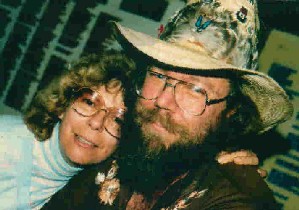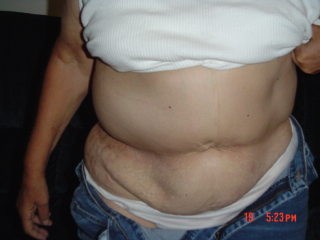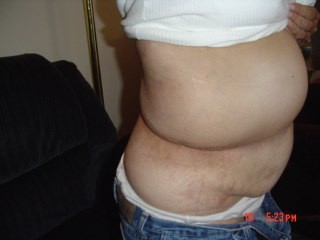Mother Of Three Fights To Beat Odds Of Pleural Mesothelioma
Sandie Knutson, a 58-year-old wife and mother of three grown children, first attributed the nagging pain on her right side from trying to do too many setups. Sandie, like most of us, knows that it is important to eat right and exercise daily. It's hard sticking to an exercise program but Sandie, determined to stay focused, ignored the pain and pushed herself to exercise daily.
The deep-seated pain continued, often waking her from a sound sleep. She found little relief from pain relievers or muscle ointments. When the area on her right side began to swell she sought medical attention from her primary care physician. On September 26, 2003, four chest films, taken at various angles, revealed a large right-sided pleural effusion. Upon review of the films, Sandie's doctor immediately sent her to Valley Hospital in Las Vegas, Nevada for a CT scan. The CT scan confirmed the large pleural effusion which doctors felt was suspicious for pneumonia. Sandie was immediately hospitalized.
That same day, a right-sided thoracentesis was performed. Removal of the fluid from her chest alleviated some of Sandie's pain. Cytological evaluation, including immunostains performed on the fluid, revealed the presence of malignant cells that were consistent with mesothelioma. A follow-up chest film, taken on September 27, 2003, showed that the pleural effusion had diminished, but densities were noted within the lung base which appeared to be related to the pleural nodules. It was recommended that an ultrasound-guided thoracentesis with a fine needle biopsy be performed to secure a positive diagnosis. The September 29, 2003 procedures were successful in retrieving 1.5 liters of fluid, which again was found to have malignant cells consistent with mesothelioma. However, the specimen taken from the fine needle biopsy of the right lung failed to survive processing for diagnostic evaluation.
Sandie's doctors ordered CT scans of the abdomen and pelvis to determine if the tumor had metastasized. No masses or ascites (abdominal effusions) were noted. On October 2, 2003, Sandie's surgeon performed a right thoracotomy, sparing the removal of the serratus muscle arising from the ribs, to obtain tissue samples of the pleura. A talc pleurodesis was administered to prevent subsequent pleural effusions. The large bore chest tube inserted for post thoracotomy drainage remained until Sandie's surgeon was confident there was no threat of a post-surgical collapsed lung or pleural effusion. The painful operation left Sandie with a nine-inch scar.
Prior to the surgery of October 2, Sandie, with her husband Dennis and family at her side, was told of the possible diagnosis of mesothelioma. Still the pathological testing of the tissue biopsy came as a devastating blow to Sandie and her family when the doctor advised that her cancer, pleural mesothelioma of epithelioid type, was incurable and that surgical intervention was not a viable treatment option.
As Sandie lay in the hospital, she realized that the shortness of breath, ankle swelling, loss of appetite and occasional night sweats she experienced over the last year were not the signs of "age catching up," but the early symptoms that are sometimes associated with mesothelioma. Like most women, Sandie put aside her aches and discomforts turning her attention to the care of her 83-year-old father who had come to live with them. She had also been preoccupied with settling into the new home that she and Dennis had recently purchased. And, just like 66 million other American women, she worked outside of the home, holding a full-time office position at a lavish entertainment hotel in Las Vegas, Nevada. Sandie, confused and angry, reflected on this and much more during her 11-day hospitalization.
Sandie was referred to an oncologist who wanted her to begin chemotherapy and radiation therapy immediately. Still reeling from the weight of the grim diagnosis, Sandie and her family contacted MARF ( www.marf.org ) for answers. Through MARF, Sandie learned of Dr. Robert Cameron of the University of California, Los Angeles School of Medicine. Sandie and her family wanted a second opinion and they wanted that opinion from an expert like Dr. Cameron.

Sandie's youngest daughter spearheaded the family's frustrating task of obtaining the medical records from all treating physicians, laboratories and the hospital; the required referral from Sandie's doctor; and, finally, the approval for the second opinion from the insurance carrier. With all tasks completed and in hand, Sandie met with Dr. Cameron on November 10, 2003.
Dr. Cameron carefully reviewed Sandie's medical records. During his review of the September 29 CT scan Dr. Cameron noted that the extensive diffuse pleural thickening found in the right thorax extended beyond the rib cage and that there appeared to be a mass in the subcutaneous space. He felt the tumor may have invaded the chest wall and ordered another CT scan. The November 13, 2003 CT scan revealed nodular thickening of the right pleura with infiltration to the right hemidiaphragm and right pericardium, the thickest region being 3.1 cm in size at the right diaphragm. Thickening of the right posterolateral chest wall substantiated Dr. Cameron's theory that the tumor had most likely spread into the right chest wall. The scan also showed a possible metastasis to the right lateral tenth rib.
Prior to Sandie's November 13, 2003 CT scan, Dr. Cameron discussed all viable treatment options. At the time of the consultation it had not been determined whether Sandie was a suitable candidate for surgery. Various experimental chemotherapy protocols including the use of chemotherapy to shrink the tumor prior to a surgical resection were also discussed. However, Dr. Cameron advised that radiation therapy in combination with chemotherapy would not be a suitable treatment option because it could significantly impair her lung function. Dr. Cameron suggested that radiation be considered as a postoperative adjuvant therapy should Sandie choose or qualify for the pleurectomy with decortication procedure.
Dr. Cameron reviewed the CT scan which confirmed the tumor had invaded the chest wall. The tumor was also attacking the blood supply to the aorta. Dr. Cameron gently informed Sandie that surgery was not an option. Sandie made the decision to begin chemotherapy. With the help of her primary care physician, Sandie was able to locate an oncologist who had been approved to administer Alimta. The oncologist was just a few miles from her home and Sandie was delighted. She began taking vitamins and B12 shots in preparation for her first cycle of Alimta/Cisplatin scheduled for December 3, 2003.
The first cycle of the Alimta/Cisplatin cocktail sent Sandie into a tailspin. Her nausea was so severe that she required hospitalization. After completing three chemotherapy treatments, Sandie was pleased to say that she had no major side effects and no hair loss. Her oncologist was pleased too, telling Sandie that she was doing better than 80% of his other patients.
Sandie was anxiously looking forward to the CT scan scheduled for January 28, 2004. She felt good and had hoped to return to work. On January 30, Sandie learned that after three cycles of chemotherapy, the tumor had not been reduced. The oncologist consulted with Dr. Cameron and both agreed to discontinue the Alimta/Cisplatin protocol.
The grim realization that the first chemotherapy protocol did not produce the positive results that Sandie had so desperately hoped for hit her hard. What was her next step? Sandie's oncologist was not ready to prescribe palliative care or take a back seat in her treatment plan. After reviewing other treatment options, her oncologist suggested a combination of radiation and chemotherapy.
On Monday, February 9, 2004, Sandie began radiation along with the chemotherapy combination of Taxol and Carboplatin. She realized the dual-treatment would drain every ounce of her physical energy, but refused to succumb to depression. Still upbeat, Sandie stated, "I guess I'll just be a 'couch potato' for a while. I just wish my DVD player was working!"
For five days a week for the next five weeks, Sandie received 26 sessions of radiation. She felt terrible. Her life as she knew it was gone. She was suppose to be caring for her 83-year-old father. For more than six years she had cared for her father and now she was helpless. She was suppose to be making a home for her and Dennis. Now he was her nursemaid. She was suppose to be doting over her six grandchildren and six great-grandchildren. Now, she didn't possess the energy to give them a "grandma bear" hug. She was suppose to be working full-time to make the mortgage payments on their new home. Now she worries they'll lose their home.
Before her diagnosis, Sandie spent her free time tending her kaleidoscopic flower garden. Now, because of the large protruding tumor, which is the length of a half loaf of bread and about two and one-half inches above the skin on her right side, she cannot even bend over to pick a flower. She loved to make the casino rounds but now her days are spent in doctors' waiting rooms. She enjoyed relaxing dinners with Dennis at their favorite restaurants at least twice a week. Today, she suffers from constant nausea. Dennis and Sandie loved to camp and dragged the family out to their favorite camp sites at least once a month. Today she can't even pull herself up off a chair. Dennis loved to bowl and Sandie planned to join his league. Now Dennis stays home and tenderly cares for her needs and their home.
When we last spoke with Sandie, she was told us she had started a third round of chemotherapy which was being administered intravenously through a port that had just been surgically placed on her right side. To rebuild her red blood cells Sandie receives daily shots of Neupogen. She also takes an antidepressant, antinauseant, and steroid medication. At 10:00 p.m. each night, Sandie takes her time-released morphine which is intended to relieve her pain. But it doesn't. The pain never goes away.
But Sandie, the woman we have come to know and respect, is a fighter, not a quitter. She is determined to fight hard, beat the odds and live with the cards she has been dealt.
*** POSTED AUGUST 4, 2004 ***


Sandi Knutson passed away on October 26, 2004


